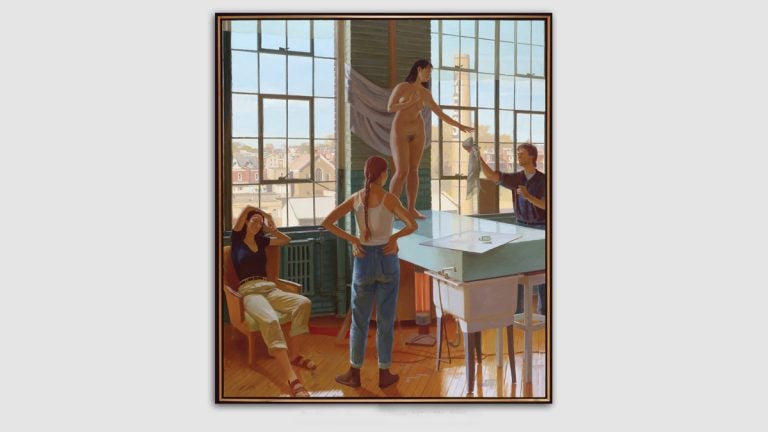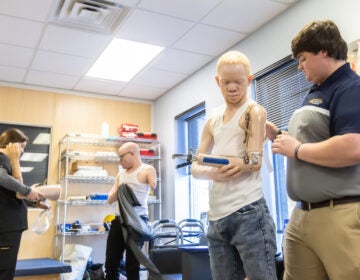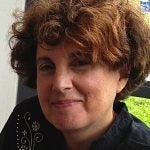A painter who shows what it’s like to be in art school

Breaking the Pose, oil on linen by Scott Noel
Scott Noel is an art school painter. That is to say, he paints life at art school. His scenes are set at the institutions for whom he’s taught: University of the Arts, Arcadia University, Community College of Philadelphia and the Pennsylvania Academy of Fine Arts, where he has been on the faculty since 1996.
In “Breaking the Pose”—a canvas that is 7 feet tall and almost equally wide—you can almost smell the oil paint that isn’t even visible in the scene surrounding a voluptuous model, one arm over a breast in modesty. She stands on a shiny glass table, positioned between two multi-paned warehouse-type windows, about the size of this canvas, offering a view of Philadelphia’s rooftops and a smokestack. The naked woman is surrounded by three clothed figures: a seated woman with her hands behind her head, a woman in a white tank top and jeans with a long skinny braid falling down her back, and a young man in blue work clothes handing the model a white cloth with which to cover up during her break. He seems focused on helping her conceal what had previously, in the moments before the time set of the painting, been the main focus of everyone’s attention.
The painting captures the irony of the nude model who freely reveals herself for painters seeking to create artwork based on what exudes from her form, yet during break reverts to modesty. At the same time, the other three figures—presumably painters, here to paint the model, yet none of them carries a brush, wears a smock nor has a speck of paint on them—are the models for this painting.
Scott Noel: An Artist’s Vision, 2000-2015, is on view at the Rider University Art Gallery through February 21. The artist will give a talk about his work February 4, 7 p.m.
Paint what you know. Noel is a painter’s painter—he paints about painting and making art. In one painting a woman runs her hands over a clay model of a nude. We only see the sculptor and the sculpture frontally in the reflection in the mirror, where we also see a man coming upon them, as if in surprise. The sculptor, caressing the shoulders of the clay figure, is experiencing an intimate moment into which the man intrudes.
Noel also likes to paint food. Pastries, pizza and fruit line the horizontal surfaces. It’s as if the setups for a still life have taken on a life of their own. Indeed in one painting, the watering can, vase and plate that had been part of an arrangement for a still life have gone flying in the air, while several jugs have fallen on the floor and shattered. But the cupcakes on the table, packaged in hard plastic clamshell holders from the baking goods department of the supermarket, reign supreme on the table that never would have fit those errant objects.
There is mystery and psychological tension in these paintings. Two women sit at a low table before an expansive window with a view onto a street with a store and a playground. One woman is absorbing the external scene, her back to the interior, while the other woman has her back to the window and her face, dark from being backlit, is focused on something she fiddles with on her arm. While there are only two characters in this scene, there are three coffee cups on the table. Certainly the painter, though unseen, is a third figure in this scene.
The artist likes to use windows and mirrors, for what they show us internally and externally, and wall partitions to show us divides in people. There are often two or more women, and the men often appear in mirrors. There are paintings hanging on the walls behind the figures, adding to the levels of reality.
Among the works are individual portraits in an art room setting, with the food and clutter that accumulate in the studio environment where art students typically spend upwards of three hours a day.
Born in Charlotte, N.C., in 1955, Noel has lived and taught in Philadelphia since 1978. In painting, “For me, the first concern is with an experience of seeing, an encounter with a place, a person, and a light,” says Noel in the exhibit catalog. “From my beginnings as a painter, the response to something seen set the imagination in motion. The narrative painters I really liked were the ones where you sense the artist
frankly deploying actors on a stage and painting the performance; hence, the attachment to theatrical life painters like Caravaggio, Velazquez, David, Degas—even Eakins and Corinth.”
He starts with a space or constellation of elements. “My psychological preoccupations are pretty simple and compulsive: I always work with a depicted encounter between a small number of people or my painted response to a sitter, portrait or nude.” He says his fidelity, as a realist, is to the “visual facts.”
In addition to people and their psychological dramas, Noel paints vegetables: rows of beautiful cabbage, beets and leeks in a Philadelphia backyard, with a corrugated metal awning and white plastic chairs. His vegetables become characters of the scene, as do the unseen gardener and the partner who sits in the other vacant chair.
“Although I think of myself as a life painter, I’m pursuing a quality in a picture only fully visible in the imagination.”
_____________________________________________________________
The Artful Blogger is written by Ilene Dube and offers a look inside the art world of the greater Princeton area. Ilene Dube is an award-winning arts writer and editor, as well as an artist, curator and activist for the arts.
WHYY is your source for fact-based, in-depth journalism and information. As a nonprofit organization, we rely on financial support from readers like you. Please give today.





